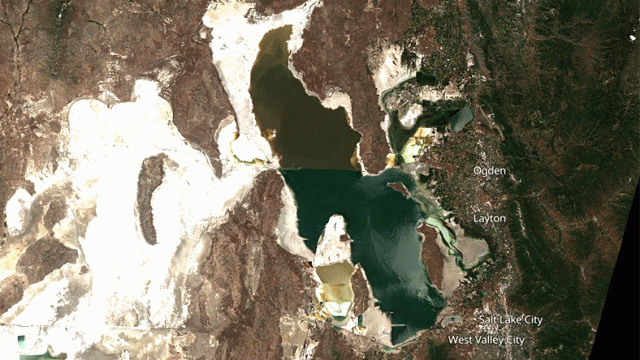Utah’s Great Salt Lake isn’t looking so great.
Over the past year, the largest terminal lake in the U.S. has kept hitting record low after record low, and this month is no exception. Earlier this month, the lake reached an average of 1,277 metres above sea level — its lowest average level on record. Only a quarter of the lake’s volume from its high point in the late 1980s now remains, the USGS said this week. Almost half its surface area is now also gone, which has exposed 2,000 square km of lakebed to the elements.
The Great Salt Lake has been in trouble for a few decades now thanks to overuse and drought — problems supercharged by climate change. Overall, the lake has dropped a total of 3.35 m since it was first measured in the 1870s. The lake is pretty shallow, just 30 feet at its deepest point, so water levels can rise and fall dramatically between years. Still, the overall downward trend since 2000 paints a clear picture of water scarcity in the West.
The lake’s situation this month is dire even compared to recent years. The gif at the top of this post shows the difference between July 2019 — when lake levels hovered around 1,278.33 m — and earlier this month; even just a few feet of difference can make pronounced changes in the coastline. Last year on July 13, the lake’s daily water level was about a foot and a half higher than where it stands now, USGS data shows.
The Great Salt Lake #Utah, 1985 – 2021 showing its high of 4,211.65 ft. ASL, 1986 to its record low of 4191.3 in 2021. #GEE script can be modified to any area in the world. #Landsat #USGS #EarthEngine #NASA https://t.co/7VFd6Wxk6c pic.twitter.com/y8mnhs2oZi
— R. Douglas Ramsey (@dramsey0425) May 4, 2022
The West’s climate-change-supercharged drought and another winter of low snowpack in Utah — which feeds most of the state’s water supply — have helped push the lake to new extremes this year. As of this week, more than 99% of the state was in severe, extreme, or exceptional drought, according to the U.S. Drought Monitor. Utah is currently on track to have its third-driest year on record.
The lake drying out has real consequences for both the environment and Utah’s economy. The lake generates around $US1.3 ($2) billion each year, from both tourism as well as industries like shrimp farming and salt mining. The lake provides habitat for wildlife, from phytoplankton to hundreds of thousands of birds. The newly exposed lakebed, meanwhile, creates a dust that brings a host of problems, affecting human health, contributing to air pollution, and making snow melt faster.
The situation at the Great Salt Lake is so dire that lawmakers in May agreed explore some desperate solutions to keep water in the lake — including piping in seawater from the Pacific Ocean hundreds of miles away.
